How Does the NHL Lottery Draft Work? Explained Clearly
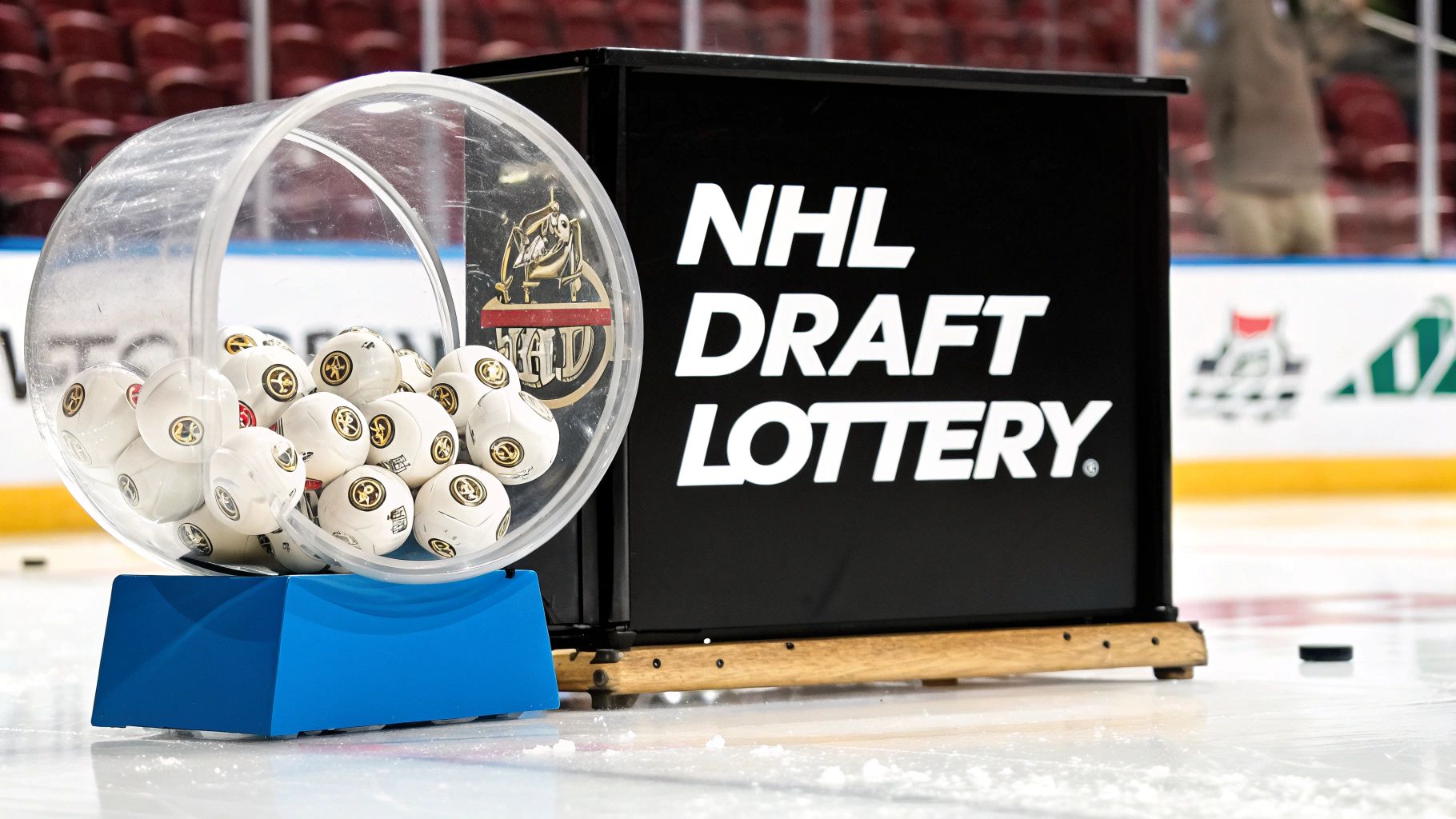
At its core, the NHL Draft Lottery is a weighted system designed to give every non-playoff team a shot at a top draft pick. It’s not just one draw; the league holds two separate drawings to determine the top two selections. This prevents the worst team from automatically landing the first overall pick.
Think of it like a raffle. The worse a team's record, the more tickets they have, but a win is never a sure thing.
A Quick Guide to the NHL Draft Lottery
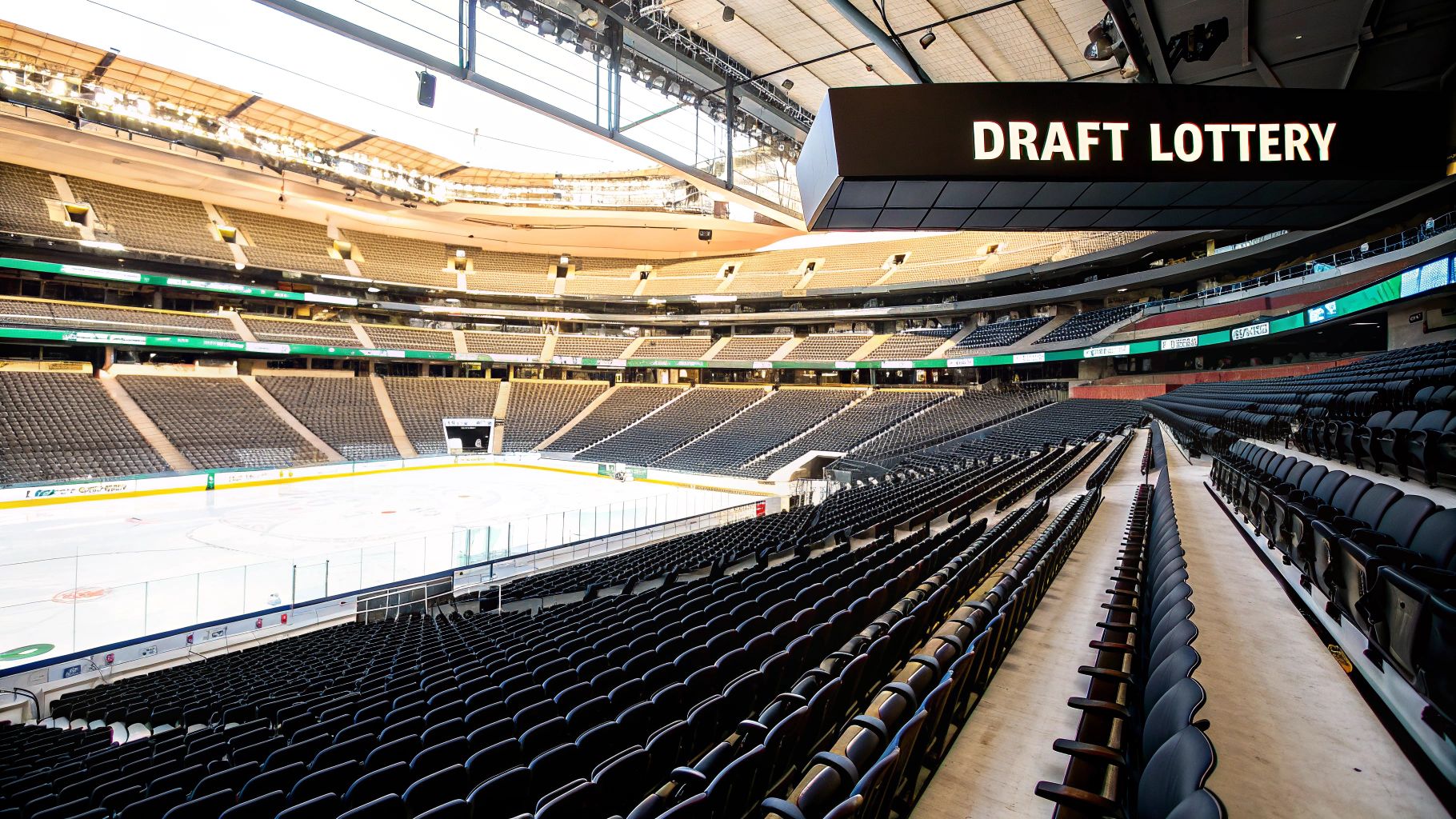
Ever wondered why the team with the league's worst record doesn't just get the first pick by default? It all comes down to the NHL’s effort to maintain competitive balance and discourage teams from "tanking"—or intentionally losing—to secure a franchise-altering prospect. The lottery adds a crucial element of chance, making the bottom of the standings a much less certain path to the top.
The system is exclusively for teams that missed the Stanley Cup Playoffs. In the 2024-25 season, that meant the 16 teams outside the postseason picture were all entered into the lottery. Each one is assigned odds based on their finish in the regular-season standings. The last-place team gets the best odds, while the team that just missed the playoffs gets the worst.
To get a clearer picture, here’s a simple breakdown of how it all works.
NHL Draft Lottery at a Glance
| Key Component | Explanation |
|---|---|
| Eligibility | Open only to the 16 teams that did not qualify for the Stanley Cup Playoffs. |
| Lottery Drawings | Two separate drawings are held: the first for the 1st overall pick and the second for the 2nd overall pick. |
| Odds System | A weighted system where odds are assigned in inverse order of the final regular-season standings. |
| Winning Limits | A team can only move up a maximum of 10 spots if they win a drawing. |
| Consecutive Wins | Teams are prohibited from winning the lottery more than twice in any five-year period. |
This table covers the basics, but let's dive a little deeper into the mechanics.
The Basic Framework
The process might seem complicated from the outside, but it’s built on a few core principles. Once you get these, the high-stakes drama that unfolds every year makes a lot more sense.
- Weighted Odds: This isn't an equal-opportunity draw. The league assigns probabilities based on where teams finished. The team dead last in the standings has the best mathematical chance of winning, but even their odds are far from a guarantee.
- Two Separate Drawings: The lottery isn’t just about the first pick. The first draw determines which team gets to select first overall. After that winner is removed, the odds are recalculated, and a second drawing determines who gets the second pick. It’s two distinct events.
- Pick Protection: After the top two spots are locked in, everything else falls into place. The remaining draft picks (3rd through 16th) are assigned based on the inverse order of the final standings, with the two lottery winners slotted into their new positions.
The whole point of the lottery is to add unpredictability. It ensures that a miserable season only offers a chance at a top pick, not a guarantee, which helps keep the games meaningful all season long.
Breaking Down the Lottery Mechanics
To really get how the NHL draft lottery works, you need to think of it less as a single event and more as a two-act play. All 16 non-playoff teams get a ticket, but a few key rules mean it’s far from a free-for-all. The whole night is built around two separate, high-stakes drawings that will change the course of a handful of franchises.
The first drawing is for the biggest prize: the first overall pick. But here’s the major twist the league added a few years back: a team can only jump up a maximum of 10 spots.
This rule completely changes the game. For example, the team with the 16th-best odds (the one that just missed the playoffs) literally cannot win the first pick. The highest they could possibly climb is to the 6th overall selection. This tweak ensures that only the league's bottom 11 teams have a legitimate shot at landing that year's top prospect.
The First Drawing Determines the Top Pick
This is the one everyone holds their breath for. A lottery machine with numbered balls spits out a winning combination, and the team assigned that combo wins the first overall pick—if they’re one of the bottom 11 teams.
If a team from the 12th to 16th spot happens to win, they simply move up their allotted 10 spots. In that scenario, the team with the worst regular-season record is automatically awarded the first overall pick by default.
This graphic gives you a great visual of how the whole thing flows.
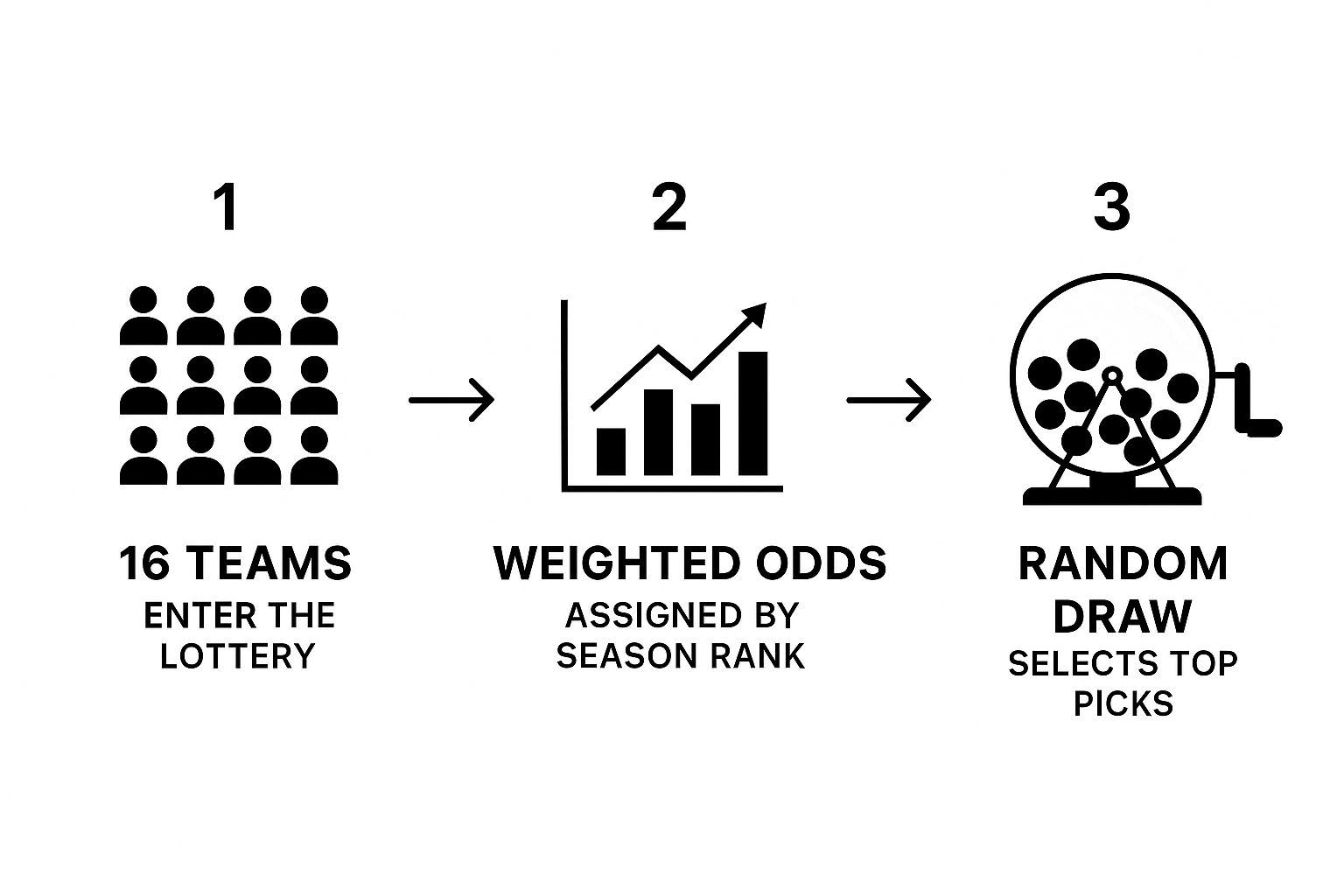
As you can see, the weighted odds give the struggling teams a better shot, but the randomness of the draw means nothing is ever guaranteed.
Recalculating Odds for the Second Draw
Once the first winner is crowned, they’re out of the running. But the lottery isn't over—this is where the second act begins. A second drawing is held to determine who gets the second overall pick.
Here’s the crucial part: the odds for the remaining teams are completely recalculated. The winning team’s probability is dropped to zero, and their odds are proportionally redistributed among the other clubs.
This means every remaining team has a slightly better chance in the second draw than they did in the first. The same 10-spot jump limit applies here, too.
This two-draw system is the NHL's way of rewarding teams that had a tough year without making it too tempting to "tank" for the top spot. After all, even the last-place team isn't guaranteed a top-two pick. You can explore more about how draft slots are finalized in our detailed guide.
The recalculation of odds between the two drawings is what makes the lottery so compelling. A team’s initial odds are just a starting point; their real fate hinges on how that first draw plays out.
After the second winner is revealed, the lottery is officially over. The remaining teams (picks 3 through 16) are then slotted into the draft order based on the inverse of their regular-season standings. It’s this blend of luck and structure that makes for must-see TV every year.
Understanding the Draft Lottery Odds
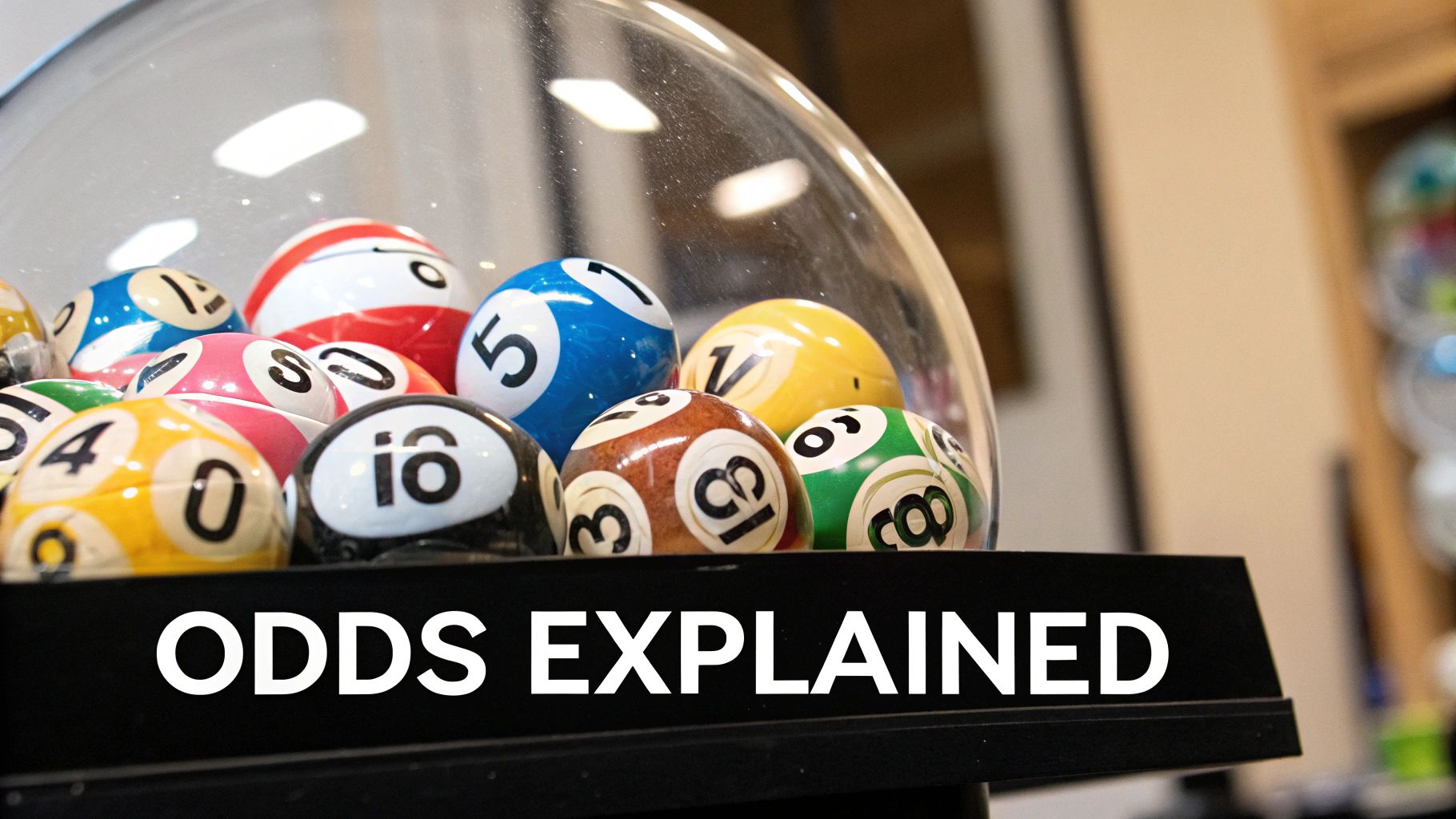
This is where the real drama of the NHL draft lottery kicks in: the numbers. The odds are the fuel for the entire event, carefully assigned to each of the 16 non-playoff teams based on one simple factor—their final spot in the regular-season standings.
Think of it as a small consolation prize for a tough year. The team that finishes dead last (32nd place overall) gets the best mathematical shot at winning the first draw. But even with the top odds, landing that coveted first-overall pick is never a sure thing. This system is designed for unpredictability, which is exactly what makes the lottery a can't-miss event for hockey fans.
How the Odds Are Assigned
The NHL assigns a specific percentage chance to each of the 16 lottery teams. It’s pretty straightforward: the last-place team gets the highest percentage, and the odds get progressively worse for every spot higher in the standings.
For example, the team with the league's worst record gets a respectable 18.5% chance to win the first draw. That's a huge leg up on the team that just missed the playoffs, which might only have a tiny 0.5% chance. That steep drop-off is intentional, designed to favour the clubs that truly struggled.
To give you a clearer picture, here’s a breakdown of the base odds for winning that all-important first draw.
NHL Draft Lottery Base Odds for the First Draw
The table below shows exactly what percentage chance each of the 16 non-playoff teams has to win the first lottery draw, from the last-place team down to the best team that missed the postseason.
| Finish Position | Odds of Winning 1st Pick |
|---|---|
| 32nd (Last Place) | 18.5% |
| 31st | 13.5% |
| 30th | 11.5% |
| 29th | 9.5% |
| 28th | 8.5% |
| 27th | 7.5% |
| 26th | 6.5% |
| 25th | 6.0% |
| 24th | 5.0% |
| 23rd | 3.5% |
| 22nd | 3.0% |
| 21st | 2.5% |
| 20th | 2.0% |
| 19th | 1.5% |
| 18th | 0.5% |
| 17th (Best Record) | 0.5% |
As you can see, the odds shrink quickly. While finishing last offers the best chance, it’s a long way from a guarantee.
Debunking a Common Lottery Myth
One of the biggest misconceptions about the lottery is that the last-place team is a heavy favourite to pick first. They have the best odds, sure, but the numbers tell a more interesting story.
With an 18.5% chance of winning, the last-place team also has a massive 81.5% chance of not winning the first overall pick. Statistically, it is far more likely that another team will win the draw.
This is the central tension that makes the lottery so compelling. The system gives the worst teams a helping hand but never a free pass. The odds are just good enough to offer hope but long enough to create genuine, nail-biting suspense. That mathematical reality is what makes the live reveal so exciting for fans and so nerve-wracking for front offices.
Keeping tabs on how these odds might shape a team's future is half the fun. You can stay ahead of the curve by exploring various NHL projections to see how the season might shake out.
The Evolution of Lottery Rules
The NHL Draft Lottery you see today is a far cry from its original, simpler form. The league has tinkered with the system for years, all with one big goal in mind: stopping teams from "tanking." That's the controversial strategy where a team basically throws its season away to get the best odds at drafting a future superstar.
https://www.youtube.com/embed/jdi6M3UNVU8
It all started as a straightforward, single-draw system. Sure, it added a little bit of chance, but it still heavily favoured the last-place team, creating a "race to the bottom" that nobody wanted to see. The NHL knew it had to protect the integrity of the game, which kicked off a series of changes to make the whole process fairer and more exciting for fans of every non-playoff team.
Those refinements led directly to the more complicated format we have now. The rules you see today—like the 10-spot jump limit and caps on how often a team can win—are a direct response to past criticisms and teams trying to game the system. Each tweak was about finding that tricky balance between helping struggling teams and killing any incentive to lose on purpose.
Major Changes to Discourage Tanking
The biggest shifts came in the mid-2010s, when the league got serious about levelling the playing field. The mission was to gut the mathematical certainty of getting a top pick just for finishing dead last, turning the lottery into a true game of chance. Understanding this history is key to knowing how the NHL draft lottery works today.
For instance, a major overhaul in 2016 introduced separate draws for the top three picks, making the event way more suspenseful. That year, the Toronto Maple Leafs had the best odds at 20%, but other teams like the Winnipeg Jets made huge jumps up the board. A few years later, the arrival of the Vegas Golden Knights as an expansion team put another spotlight on how the lottery’s structure can impact the entire league. You can explore more about the history of the NHL draft lottery and its effects on Canadian teams.
But the evolution didn't stop there. The league kept fine-tuning things, eventually landing on the two-draw format we have today.
The core idea behind these changes was simple: make tanking a high-risk, low-reward strategy. By limiting how far a team can jump and how many times they can win, the NHL ensures that on-ice effort remains the most reliable path to success.
Key Rule Introductions Over the Years
To really see how we got here, just look at these crucial rule changes over time:
- Flattened Odds: The league tweaked the probabilities, giving teams outside the bottom few spots a much better mathematical shot at winning. This meant finishing last was no longer the golden ticket it once was.
- 10-Spot Jump Limit: Rolled out in 2021, this rule stops teams on the playoff bubble from vaulting all the way to first overall. Now, only the bottom 11 teams even have a chance at the top pick.
- Win Restrictions: A team can now win the lottery a maximum of two times in any five-year period. This prevents one franchise from hoarding top-tier talent through sheer lottery luck.
Famous Lottery Wins and Heartbreaks
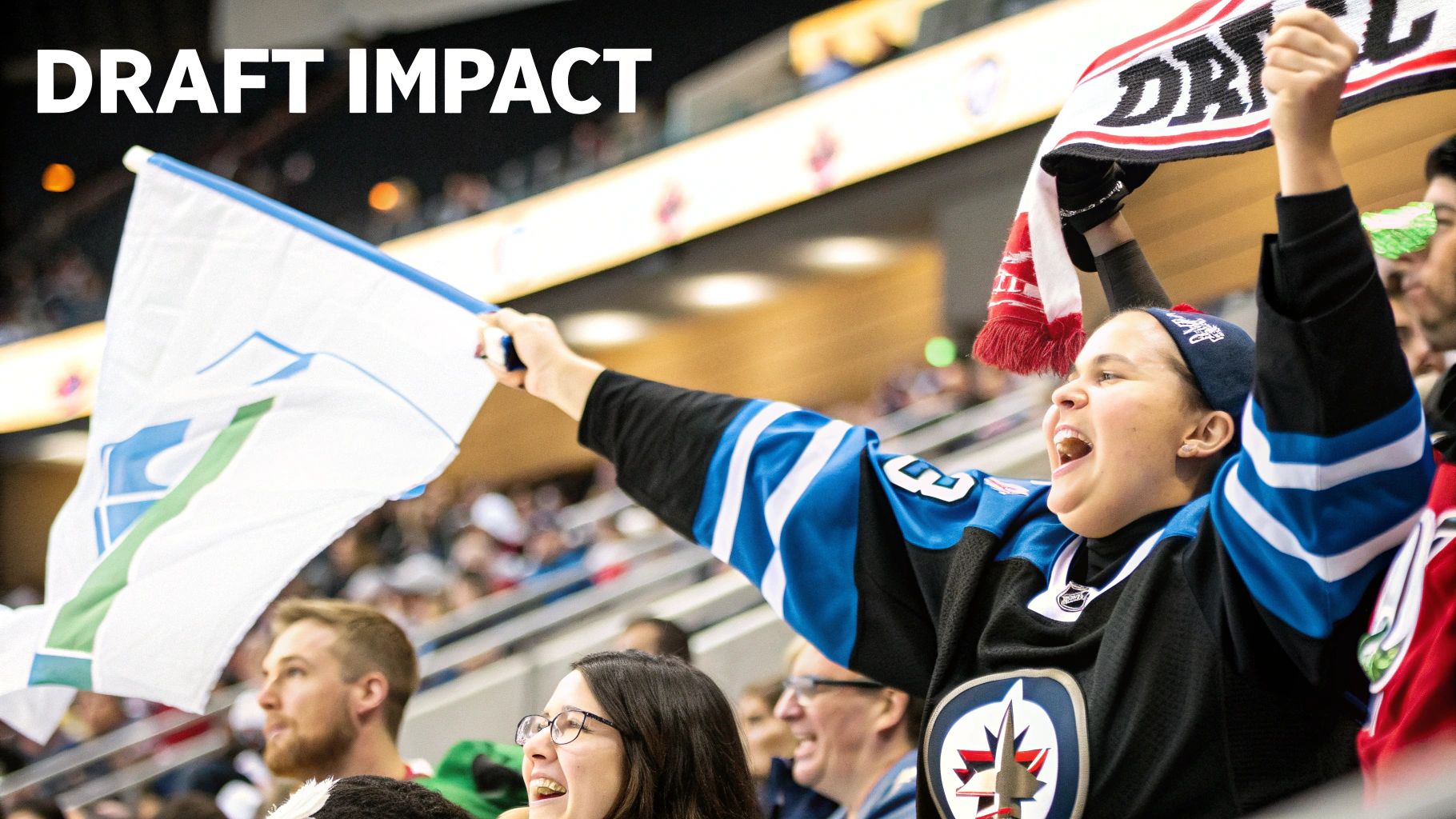 The odds and rules are one thing on paper, but the real magic of the NHL Draft Lottery happens when the cards are revealed live. For a handful of franchises, a few bouncing lottery balls have completely altered their trajectory, accelerating a rebuild or delivering a crushing blow to their long-term plans.
The odds and rules are one thing on paper, but the real magic of the NHL Draft Lottery happens when the cards are revealed live. For a handful of franchises, a few bouncing lottery balls have completely altered their trajectory, accelerating a rebuild or delivering a crushing blow to their long-term plans.
This is where the abstract numbers become pure, high-stakes drama. A single lottery win can inject immediate hope and elite talent into a struggling organization. It’s the kind of franchise-defining moment that can shave years off a rebuild by delivering a cornerstone player to build around for the next decade.
On the flip side, a heartbreaking drop in the draft order can feel like a punch to the gut. For a team that just endured a miserable season, falling from the top spot can delay their return to contention and force the front office to completely rethink its strategy.
The Thrill of the Unexpected Jump
Some of the most memorable lottery nights involve a team with long odds making a shocking leap up the draft board. This is the ultimate proof of the lottery's beautiful unpredictability—and it shows exactly how the system gives every non-playoff team a chance, no matter how slim.
When a team jumps multiple spots, it’s not just a win for them; it sends ripples across the league. Other teams get pushed down, forcing them to alter their draft plans on the fly.
A classic example? The 2017 NHL Draft Lottery. The Philadelphia Flyers came in with just a 2.4% chance of landing a top-three pick but defied the odds, jumping from the 13th position all the way to No. 2. That incredible luck allowed them to select Nolan Patrick, a move that reshaped the entire top end of that year's draft.
When the Favourite Holds Serve
While upsets are thrilling, it’s just as significant when the team with the best odds actually wins. This outcome gives a struggling franchise the exact reward they hoped for after a gruelling season. These wins validate the weighted system, confirming that the league’s worst teams really do get the best chance at recovery.
A recent example of this was the Montreal Canadiens winning the lottery in 2022 with the best odds, using the top pick to select Juraj Slafkovsky. While the system is designed to favour the last-place teams, nothing is ever guaranteed. Discover more insights about past lottery winners.
Landing a generational talent like Connor McDavid (Edmonton Oilers, 2015) or Connor Bedard (Chicago Blackhawks, 2023) can instantly change a team’s fortunes, impacting everything from ticket sales to their overall financial health. A top prospect can fundamentally alter the numbers on a team's books, a crucial factor you can track with an NHL salary cap tracker.
These moments—both the lucky jumps and the expected victories—are what make the lottery a cornerstone event on the NHL calendar. It's a night of pure chance where a franchise's future can change in an instant.
Common NHL Draft Lottery Questions
Even after you get the hang of the rules and odds, some of the finer points of the NHL draft lottery can still be tricky. We'll clear up some of the most common questions here, covering everything from repeat winners to what happens with traded picks.
Think of this as putting the final pieces of the puzzle together. By the end, you'll have a complete picture of one of the most exciting nights on the hockey calendar.
Can a Team Win the NHL Draft Lottery Multiple Times?
Yes, they can—but there’s a big catch. The NHL put a rule in place to stop one franchise from getting too lucky and stockpiling a generation of top talent.
A team can only win a lottery drawing a maximum of two times in a five-year window. This was brought in to help level the playing field and give more clubs a legitimate shot at landing a franchise-altering player.
So, what happens if a team that's already won twice in the last four years wins again? Simple: the draw gets tossed out. They just pull another combination until an eligible team comes up.
What Happens if a Playoff Team Owns a Lottery Pick?
This is where the trade deadline gets really interesting. If a team headed for the playoffs trades for a non-playoff team’s first-round pick, that pick keeps its original lottery eligibility.
The playoff team basically steps into the shoes of the team they got the pick from, inheriting their lottery odds. For instance, if a Stanley Cup contender grabs the last-place team’s first-rounder, they’ll head into the lottery with the best odds at 18.5%.
This is exactly why you see rebuilding teams shipping out veteran players for future first-round picks. It’s a calculated risk for the contender, who hopes a bit of lottery magic can net them an elite prospect without having to suffer through a miserable season themselves.
How Did Tanking Influence Current Lottery Rules?
“Tanking”—the not-so-subtle strategy of losing on purpose to get better draft odds—is the entire reason the lottery was created and why it keeps changing. The league needed to introduce an element of chance to discourage teams from racing to the bottom of the standings.
Early versions of the lottery, however, still gave the worst team a massive advantage. So, the NHL kept tweaking the system to make tanking a much riskier bet.
Here are the key changes made specifically to fight tanking:
- Flattening the odds to give teams outside the bottom few a better shot.
- Adding the 10-spot jump limit to stop a team just outside the playoffs from winning the whole thing.
- Capping teams at two lottery wins in a five-year period.
These rules mean that even the team that finishes dead last isn't guaranteed a top-two pick, which really dials back the incentive to lose.
Are All Non-Playoff Teams Eligible for the First Pick?
Nope, and this is probably one of the most misunderstood parts of the modern lottery. Thanks to the rule that a team can only jump up a maximum of 10 spots, a few teams are mathematically out of the running for the first overall pick before a single ball is drawn.
Only the teams with the top 11 odds—the ones who finished in the bottom 11 of the league standings—have any chance at all of landing that coveted number one selection.
For example, the team with the 12th-best odds can, at best, vault up to the 2nd overall pick. The team with the 16th-best odds? The highest they can climb is to the 6th overall pick. This change really focuses the grand prize on the teams that truly struggled the most.
At PuckNStick, we live for the data that drives the game. From draft analytics to player performance metrics, we provide the tools you need to understand hockey at a deeper level. Explore our comprehensive stats and analysis today at https://www.pucknstick.com.
